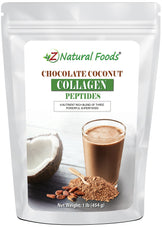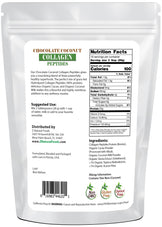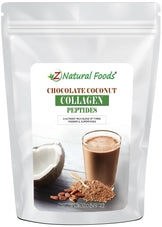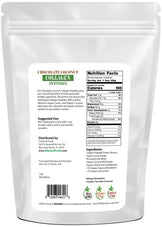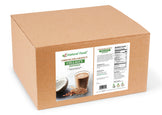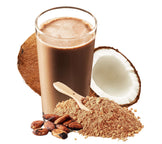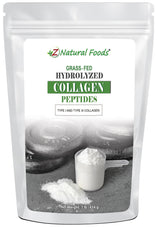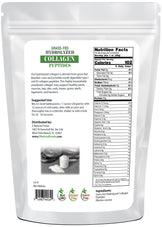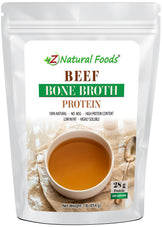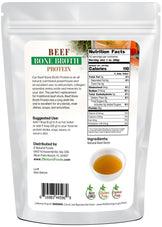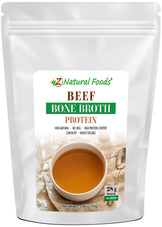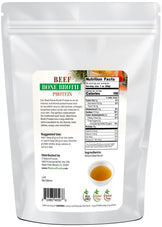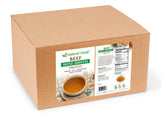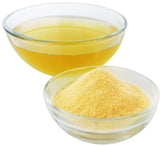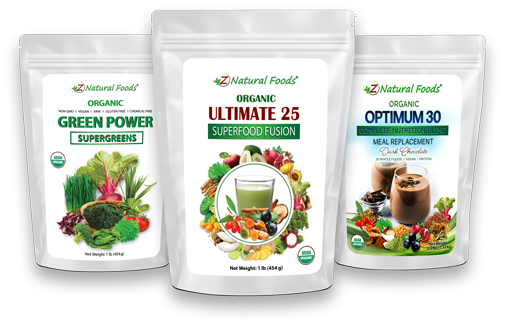Description
Description
Collagen and bone broth products have garnered significant attention in the realms of health, wellness, and beauty, prompting a surge in inquiries about their benefits, sources, and uses.
This introduction serves as a primer to address frequently asked questions, providing a comprehensive overview of collagen protein, its role in the body, and its potential health benefits.
Collagen is the most abundant protein in the human body, playing a crucial role in maintaining the structure and integrity of various tissues, hair, nails, skin, bones, tendons, and ligaments. It's essentially the glue that holds our body together.
As we age, our body's natural collagen production decreases, weakening our structural integrity. The growing interest in collagen supplements has led to their widespread availability in various forms, such as powders, capsules, and liquids.
These supplements are typically derived from animal sources, including bovine (cow), porcine (pig), and marine (fish) collagen. While each source has the amino acids needed to create collagen, each source is rich in a specific collagen type, contributing to its benefits and uses.
Now, we answer some of the most frequently asked questions at ZNF about collagen's properties and uses.
1) What is Collagen?
Collagen is a protein the body produces that supports the structure and function of hair, skin, nails, cartilage, bones, blood vessels, and connective tissue. It is the human body's most abundant protein, representing 35% of its dry weight. It comprises 19 essential and nonessential amino acids and three chains wound into a tight helix, each 1400 amino acids long.
Collagen is primarily made up of the amino acids Glycine (33% of total collagen), hydroxyproline and proline (22% of total collagen), and glutamate (derived from its precursor glutamine and an essential precursor for proline).
Next, let's review the attributes of a popular form known as collagen peptides. Collagen peptides may go by several other names, like collagen hydrolysate and hydrolyzed collagen. All collagen, by definition, is technically hydrolyzed, but there are different levels to this process(partially and fully).
For example, gelatin is partially hydrolyzed, and collagen peptides are fully hydrolyzed. Finally, hydrolyzed collagen is, by definition, a denatured protein. Now, to understand what hydrolyzed collagen is, it is also essential to understand the hydrolyzation process. Hydrolyzed collagen is created through hydrolysis, a process where water molecules rupture the chemical bond.
Finally, let's compare the difference between gelatin and hydrolyzed collagen.
This comparison is about something other than which form is better; it is for clarification so you understand these raw materials' use and proper application. As mentioned earlier, there are two levels to the hydrolyzation process: Partially and fully hydrolyzed.
Gelatin is a partially hydrolyzed collage because it does not go through the crucial step of being broken down by enzymes. Partially hydrolyzed gelatin also has a higher molecular weight, making it soluble only in hot water and solidifying in cold water. While this makes a superior ingredient as a thickening agent in soups, stews, and desserts, it is also excellent for making gummies.
However, some might consider this less versatile. You may also know this raw material by its other name, JELLO. As your mother used to tell you, “There is always room for jello.” Fully hydrolyzed collagen (collagen peptides) is soluble in hot and cold liquids and highly versatile. In simple terms, gelatin is the cooked form of collagen, and hydrolyzed collagen is gelatin that has been more highly processed to break up the protein chain for better absorption.
2) What are the Benefits of Collagen?
While the most well-documented benefits of collagen support all aspects of the body’s structural integrity (Hair, Skin, Nails, Joints, Tendons, and Ligaments), each source is known for being abundant in specific types of collagen. This creates a more targeted approach to why you may use specific types of collagen.
Chicken Collagen
Chicken comprises Type II collagen, found in elastic cartilage, which gives cartilage strength and elasticity and provides joint support. It also supports the binding process with the help of fibronectin(A glycoprotein that plays an essential role in tissue repair) and other collagens. This type of collagen is derived from chicken sternum cartilage. In simple terms, type 2 collagen is a peptide and component of joint cartilage. Type 2 collagen can be found as hydrolyzed or undenatured.
Beef Collagen
A good portion of the market's hydrolyzed/ peptide collagen products come from beef bones(unless otherwise noted) and are a quality source of Types I and III. As mentioned earlier in the article,
- Type I makes up 90% of your body’s collagen and is densely packed to provide structure for your skin, bones, tendons, and ligaments.
- Type III is a significant extracellular matrix component found in muscles, arteries, blood vessels, and organs. Specific to tissues with large portions of elastic fibers. Type III collagen also interacts with platelets in the blood clotting cascade and is an essential signaling molecule in wound healing.
Marine Collagen
Type 1 collagen: The superstar of collagen from the sea
Type I collagen comprises 90% of your body’s collagen and is densely packed to provide structure for your skin, bones, tendons, and ligaments; this can be found in highly nourishing quantities in marine collagen. As a side note, type III collagen is another type of fibrillar collagen often associated with type I.
Type III is thinner and present in high concentrations in the skin and blood vessels. While much more human research is needed, Marine collagen has been shown in preliminary research and some small clinical studies to support skin health.
3) What Causes Collagen Depletion?
The foundation of the human structure is a perfect creation of bones, joints, ligaments, cartilage, tendons, and muscles. These moving parts have been strategically placed to support one another to optimize movement, agility, and strength and to protect our anatomy and physiology.
In simple terms, it is support for optimally surviving and thriving. Unfortunately, our natural collagen production begins to slow as we age, and these essential parts break down. This natural process begins to weaken the cell structures that support our structural foundation.
While it is believed the group of enzymes called collagenases is responsible for collagen degradation, our lifestyle habits may be the most significant factor in accelerating this natural process. While excessive exposure to sunlight, smoking, and sugar play a direct role in this process, a diet lacking the essential ingredients for supporting healthy collagen levels is one of the top reasons for this process.
Vitamin C and the amino acids proline, hydroxyproline, and glycine are essential components in supporting the process known as collagen synthesis. Collagen synthesis is a complex multistep process that requires many different structures within and outside of collagen-producing cells within connective tissue, known as fibroblasts.
4) How Can You Increase Collagen Production?
There are various effective methods to possibly support healthy collagen levels through diet and lifestyle.
First, what you avoid can be as important as what you consume. So, make sure to avoid smoking, excessive sun exposure, sugar, and processed food intake, and manage your stress levels. For clarity, when we say don’t get excessive sun exposure, it does not mean to get no sun exposure. It means don’t sit out in the sun for hours at a time because sun exposure is essential for vitamin D synthesis.
Next, consume foods and supplements rich in naturally occurring collagen—for example, hydrolyzed collagen, a.k .a. peptides, gelatin powder, or bone broth. Also, specific cuts of meat that need to be cooked low and slow(short ribs and chuck roast)are excellent sources of collagen, as are stocks made with beef, pork, or fish bones. Ensuring you get adequate amounts of vitamin C from foods like citrus and berries is also essential for proper collagen synthesis. Vitamin C prevents the auto-inactivation of two critical enzymes in collagen biosynthesis.
Finally, consider supplementing with a formula that contains either the amino acids proline, glycine with a food source of vitamin C, or a choline silicon blend as a stabilized orthosilicic acid.
5) Is Collagen Powder Effective?
Research on the effectiveness of collagen supplements is ongoing, but many studies suggest that various forms of collagen products have produced effective results for a wide range of structural conditions.
- In a randomized controlled trial to determine the efficacy of undenatured type 2 collagen in modulating knee osteoarthritis symptoms, the results showed that the collagen group demonstrated a significant reduction in the overall WOMAC score (Western Ontario McMaster Universities Osteoarthritis Index) compared to the placebo group. Therefore, it was concluded that this specific form of undenatured type 2 collagen is well tolerated and improves knee symptoms.
- While more human research is necessary, there is preliminary evidence that speaks to the potential of beef-sourced collagen. An article titled Collagen hydrolysate for the treatment of osteoarthritis and other joint disorders: A literature review concluded that a growing body of evidence provides a rationale for using collagen supplements for people with Osteoarthritis.
- In a double-blind, placebo-controlled, randomized clinical study on the effectiveness of collagen peptides on knee Osteoarthritis specific to improvement in treatment, “There was a significant reduction from baseline to Visit 7 in the primary endpoints of WOMAC and VAS scores and the secondary endpoint of QOL score in subjects with PCP and BCP groups, while in subjects with the placebo group, the endpoint indices remained unaltered. Furthermore, all the WOMAC, VAS, and QOL score levels decreased significantly (P < 0.01) in the study group compared to the placebo group in Visit 7.” Therefore, it was concluded, “The study demonstrated that collagen peptides are potential therapeutic agents as nutritional supplements for the management of osteoarthritis and maintenance of joint health.”
6) What are the Different Types of Collagen?
While there are technically 28 types of collagen that differ based on molecular assembly, cell components added, and where the collagen is used in the body, there are five primary types:
- Type I makes up 90% of your body’s collagen and is densely packed to provide structure for your skin, bones, tendons, and ligaments.
- Type II is found in elastic cartilage, gives cartilage strength and elasticity, and provides joint support. It supports the binding process with the help of fibronectin (A glycoprotein that plays an essential role in tissue repair) and other collagens.
- Type III is a significant extracellular matrix component found in muscles, arteries, blood vessels, and organs. Specific to tissues with large portions of elastic fibers. Type III collagen also interacts with platelets in the blood clotting cascade and is an essential signaling molecule in wound healing.
- Type IV is the primary component of basement membranes (thin layers of the extracellular matrix that form supportive structures) found in layers of your skin, forming their backbone.
- Type V is a fibrillar collagen (essential for forming collagen fibers)of types I and III collagen, optimal for the formation and quality of tissue. Type V collagen contributes to the bone matric, corneal stroma, and interstitial matrix of muscles, liver, lungs, and placenta.
NOTE: Z Natural Foods' Hydrolyzed Collagen Peptides (Grass-fed) contain Type I and Type III.
7) What is the difference between beef, chicken, and marine collagen?
In simple terms, this comes down to the animal from which the collagen is sourced.
It is essential to understand that while each source primarily contains an abundance of one or two specific types of collagen, all sources have small amounts of a wide range of collagen types.
As we cover the collagen questions, it is essential to also discuss a fantastic foundational food– bone broth – that, when prepared correctly, is an outstanding source of collagen.
8) What is Bone Broth?
Because there is a direct association between collagen and bone broth, we decided to add this final question.
Bone broth has a very long and healthy tradition in various cultures, with family recipes passed down from generation to generation. According to TCM, bone broth builds blood, Qi (The energy and vital essence that allows for all things to exist), and essence, and it nourishes the kidneys. TCM believes that the kidneys store what is known as the “life force,” or Jing (the life essence responsible for all growth cycles.
Bone broth is a nourishing and healing food made from a combination of bones like the humerus, spine, pelvic girdle, scapula, and sternum with parts rich in gelatin, like feet. While not a great source of quantitative amounts of protein, it is a quality source of amino acids used explicitly for potentially restoring good health. Bone broth is one of the most traditional foods in every culture used as a tool for nourishing and healing what ails you, and some traditionalists believe that it could be one of the most nourishing foods on earth.
Bones, marrow, and connective tissue not only contain all the necessary materials needed to keep the structural foundation of our body strong and healthy, but they also yield a broad spectrum of essential vitamins and minerals when sourced adequately and appropriately prepared.
Bones contain calcium, phosphorus, magnesium, and potassium. The connective tissue material found in feet is rich in the building blocks for joint health, like glucosamine and chondroitin. Unlike taking those compounds in supplement form, this is a direct useable source. Bone marrow (the spongy and dense tissue that fills the inside of bones) is a quantitative source of vitamins A, B2, and B12, essential fatty acids, calcium, iron, selenium, and zinc. But beyond these tremendous components, bone marrow also contains unique cofactors that may support deep nourishment beyond the basics.
There are two types of bone marrow:
- Red bone marrow helps produce blood cells containing hematopoietic stem cells.
- Yellow marrow helps store fat and mesenchymal stem cells.
Bone marrow produces red and white blood cells and platelets. Lymphocytes are also made in the marrow, which supports specific immune system responses. All of these intrinsic compounds are found in bone broth.
For more information about our Hydrolyzed Collagen powder (Bovine), go here:
For more information about our Hydrolyzed Marine Collagen powder, go here:
Hydrolyzed Marine Collagen Peptides (Unflavored)
For more information about our Chicken Bone Broth Protein, go here:
For more information about all of our collagen powders, go here:



